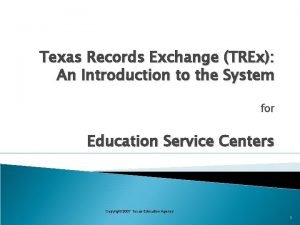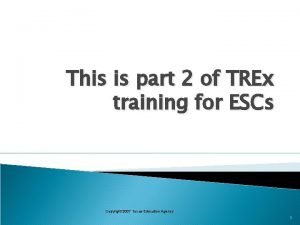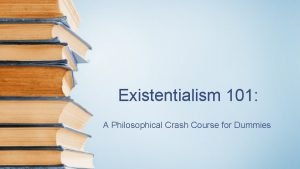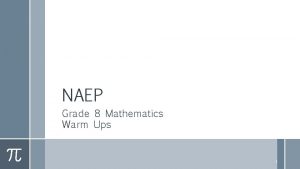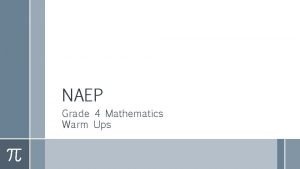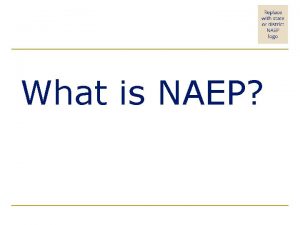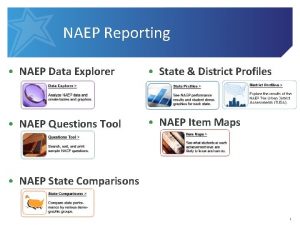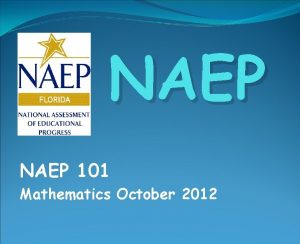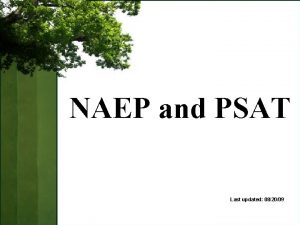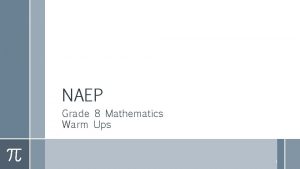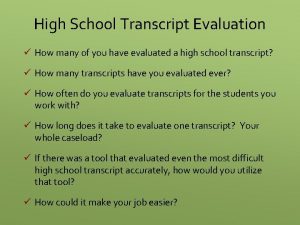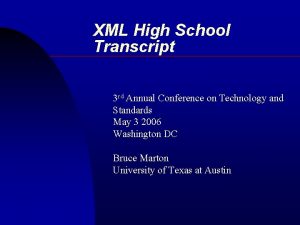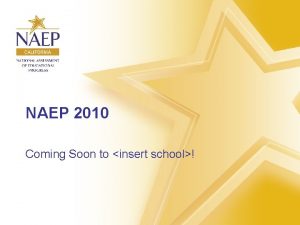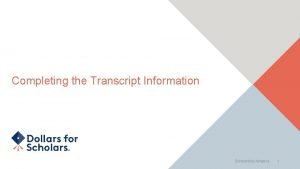THE 2005 NAEP HIGH SCHOOL TRANSCRIPT STUDY THE


































- Slides: 34

THE 2005 NAEP HIGH SCHOOL TRANSCRIPT STUDY

THE 2005 HIGH SCHOOL TRANSCRIPT STUDY Today’s Presentations

o r t C a r d : 2 0 0 5 A s s e s s m

4

5

* Significantly different (p <. 05) from 2005. SOURCE: U. S. Department of Education, Institute of Education Sciences, National Center for Education Statistics, National Assessment of Educational Progress (NAEP), various years, 1992– 2005 Reading Assessments. 6

* Significantly different (p <. 05) from 2005. SOURCE: U. S. Department of Education, Institute of Education Sciences, National Center for Education Statistics, National Assessment of Educational Progress (NAEP), various years, 1992– 2005 Reading Assessments. 7

* Significantly different (p <. 05) from 2005. 1 Sample sizes were insufficient to permit a reliable estimate for American Indian/Alaska Native students in 1992, 1998, and 2002. NOTE: Race categories exclude Hispanic origin. SOURCE: U. S. Department of Education, Institute of Education Sciences, National Center for Education Statistics, National Assessment of Educational Progress (NAEP), various years, 1992– 2005 Reading Assessments. 8

* Significantly different (p <. 05) from 2005. NOTE: Score gaps are calculated based on differences between unrounded average scores. SOURCE: U. S. Department of Education, Institute of Education Sciences, National Center for Education Statistics, National Assessment of Educational Progress (NAEP), various years, 1992– 2005 Reading Assessments. 9

10

SOURCE: U. S. Department of Education, Institute of Education Sciences, National Center for Education Statistics, National Assessment of Educational Progress (NAEP), 2005 Mathematics Assessment. 11

SOURCE: U. S. Department of Education, Institute of Education Sciences, National Center for Education Statistics, National Assessment of Educational Progress (NAEP), 2005 Mathematics Assessment. 12

NOTE: Race categories exclude Hispanic origin. SOURCE: U. S. Department of Education, Institute of Education Sciences, National Center for Education Statistics, National Assessment of Educational Progress (NAEP), 2005 Mathematics Assessment. 13

SOURCE: U. S. Department of Education, Institute of Education Sciences, National Center for Education Statistics, National Assessment of Educational Progress (NAEP), 2005 Mathematics Assessment. 14

THE 2005 NAEP HIGH SCHOOL TRANSCRIPT STUDY

THE 2005 HIGH SCHOOL TRANSCRIPT STUDY National study representing 2. 7 million 2005 high school graduates n based on 26, 000 transcripts n over 700 public and private schools The 2005 NAEP High School Transcript Study (HSTS) examines coursetaking patterns and grades n trends over time n demographic differences n associations with NAEP achievement 16

THE 2005 HIGH SCHOOL TRANSCRIPT STUDY 17

THE 2005 HIGH SCHOOL TRANSCRIPT STUDY Graduates earned more credits than previous graduates Graduates earned more credits in… § core courses § other academic courses but did not earn more credits in other courses Core credits Other academic credits Other credits * Significantly different from 2005. NOTE: Details may not sum to total because of rounding. Numbers above the bars represent total credits. Core credits are English, mathematics, science, and social studies. Other academic credits are fine arts, foreign languages, and computer-related studies. Other credits include all other courses such as vocational education, personal health, 18 and physical education. SOURCE: U. S. Department of Education, Institute of Education Sciences, National Center for Education Statistics, High School Transcript Study (HSTS), various years, 1990— 2005.

THE 2005 HIGH SCHOOL TRANSCRIPT STUDY Curriculum Levels Standard: 4 credits – English; 3 each - social studies, mathematics, and science Midlevel: Standard credits plus more challenging requirements for mathematics and science, and a foreign language requirement Rigorous: Midlevel plus additional credits for mathematics and foreign language 19

THE 2005 HIGH SCHOOL TRANSCRIPT STUDY More graduates completed at least a standard curriculum Standard Midlevel Rigorous * Significantly different from 2005. NOTE: Details may not sum to total because of rounding. Numbers above the bars represent the percentage completing at least a standard curriculum. 20 SOURCE: U. S. Department of Education, Institute of Education Sciences, National Center for Education Statistics, High School Transcript Study (HSTS), various years, 1990— 2005.

THE 2005 HIGH SCHOOL TRANSCRIPT STUDY The pattern for mathematics coursetaking is, in large part, set in the freshman year PERCENT COMPLETING SPECIFIC COURSE BY END OF HIGH SCHOOL Geometry Algebra II Advanced mathematics/ calculus * Significantly different from below algebra I. NOTE: Advanced mathematics includes courses, other than calculus, that are generally taken after algebra II (e. g. , AP statistics and precalculus). 21 SOURCE: U. S. Department of Education, Institute of Education Sciences, National Center for Education Statistics, High School Transcript Study (HSTS), 2005.

THE 2005 HIGH SCHOOL TRANSCRIPT STUDY 22

THE 2005 HIGH SCHOOL TRANSCRIPT STUDY Graduates taking calculus or advanced mathematics courses have higher average NAEP mathematics scores Graduates taking physics or other advanced science courses have higher average NAEP science scores * Significantly different from next highest level completed. NOTE: Advanced mathematics includes courses, other than calculus, that are generally taken after algebra II (e. g. , AP statistics and precalculus). Advanced science courses are science courses typically taken after physics (e. g. , AP physics and IB chemistry). 23 SOURCE: U. S. Department of Education, Institute of Education Sciences, National Center for Education Statistics, High School Transcript Study (HSTS), 2005.

THE 2005 HIGH SCHOOL TRANSCRIPT STUDY 24

THE 2005 HIGH SCHOOL TRANSCRIPT STUDY Females completed more midlevel and rigorous curricula than males Rigorous Midlevel Standard Less than standard * Significantly different from males. NOTE: Details may not sum to total due to rounding. 25 SOURCE: U. S. Department of Education, Institute of Education Sciences, National Center for Education Statistics, High School Transcript Study (HSTS), 1990 and 2005.

THE 2005 HIGH SCHOOL TRANSCRIPT STUDY Males earned higher NAEP mathematics scores than females completing the same level of mathematics courses Males had higher NAEP science scores than females completing the same level of science courses Male Female * Significantly different from males. NOTE: Advanced mathematics includes courses, other than calculus, that are generally taken after algebra II (e. g. , AP statistics and precalculus). Advanced science courses are science courses typically taken after physics (e. g. , AP physics and IB chemistry). 26 SOURCE: U. S. Department of Education, Institute of Education Sciences, National Center for Education Statistics, High School Transcript Study (HSTS), 2005.

THE 2005 HIGH SCHOOL TRANSCRIPT STUDY 27

THE 2005 HIGH SCHOOL TRANSCRIPT STUDY Black graduates closed a 6 percentage point gap with White graduates in the percent completing a curriculum level at or above midlevel since 1990 * Significantly different from 2005. 28 SOURCE: U. S. Department of Education, Institute of Education Sciences, National Center for Education Statistics, High School Transcript Study (HSTS), various years, 1990— 2005.

THE 2005 HIGH SCHOOL TRANSCRIPT STUDY The 2005 gap between White and Hispanic graduates completing curricula at or above midlevel was not different from 1990 * Significantly different from 2005. 29 SOURCE: U. S. Department of Education, Institute of Education Sciences, National Center for Education Statistics, High School Transcript Study (HSTS), various years, 1990— 2005.

THE 2005 HIGH SCHOOL TRANSCRIPT STUDY White graduates had higher average NAEP mathematics scores than Black graduates completing the same mathematics course White Black * Significantly different from White graduates. ‡ Insufficient sample size for reliable estimate. NOTE: Advanced mathematics includes courses, other than calculus, that are generally taken after algebra II (e. g. , AP statistics and precalculus). 30 SOURCE: U. S. Department of Education, Institute of Education Sciences, National Center for Education Statistics, High School Transcript Study (HSTS), 2005.

THE 2005 HIGH SCHOOL TRANSCRIPT STUDY White graduates outperformed Hispanic graduates completing the same mathematics course on average NAEP mathematics assessment White Black Hispanic * Significantly different from White graduates. ‡ Insufficient sample size for reliable estimate. NOTE: Advanced mathematics includes courses, other than calculus, that are generally taken after algebra II (e. g. , AP statistics and precalculus). 31 SOURCE: U. S. Department of Education, Institute of Education Sciences, National Center for Education Statistics, High School Transcript Study (HSTS), 2005.

THE 2005 HIGH SCHOOL TRANSCRIPT STUDY Asian/Pacific Islander graduates outperformed both Black and Hispanic graduates White Black Hispanic Asian/Pacific Islander * Significantly different from White graduates. ‡ Insufficient sample size for reliable estimate. NOTE: Advanced mathematics includes courses, other than calculus, that are generally taken after algebra II (e. g. , AP statistics and precalculus). 32 SOURCE: U. S. Department of Education, Institute of Education Sciences, National Center for Education Statistics, High School Transcript Study (HSTS), 2005.

For More Information http: //nationsreportcard. gov 33

 High school transcript study
High school transcript study Pisa
Pisa Trex texas
Trex texas Aice diploma benefits
Aice diploma benefits Alvin high school transcript
Alvin high school transcript Angie jilek
Angie jilek Norwalk high school transcript request
Norwalk high school transcript request 2006 calendar year
2006 calendar year Trex tracking number
Trex tracking number Hot fuzz transcript
Hot fuzz transcript Crash course existentialism
Crash course existentialism Coventry university transcript
Coventry university transcript Jmu physical therapy
Jmu physical therapy Barry university official transcript
Barry university official transcript Jjc transcript
Jjc transcript Rcbc transcript request
Rcbc transcript request Bernard tschumi the manhattan transcripts
Bernard tschumi the manhattan transcripts Signing naturally 6.15 i wanna be different answers
Signing naturally 6.15 i wanna be different answers Cwu unofficial transcript
Cwu unofficial transcript Keller isd transcript
Keller isd transcript Bowling for columbine oscar
Bowling for columbine oscar Lone star college alternative teacher certification program
Lone star college alternative teacher certification program Gene transcript
Gene transcript Severn suzuki speech transcript
Severn suzuki speech transcript Uncg course equivalency
Uncg course equivalency Uh my
Uh my Glendale community college transcript
Glendale community college transcript Nursing program glendale
Nursing program glendale Atlanta public schools transcript request
Atlanta public schools transcript request Csu channel islands application deadline
Csu channel islands application deadline Uniface 9
Uniface 9 Cpcc blackboard
Cpcc blackboard Crescenta valley high school graduation 2021
Crescenta valley high school graduation 2021 Assignment in spanish
Assignment in spanish Ecological study vs cohort study
Ecological study vs cohort study


